Estimation of the Seawater Lidar Ratio by MODIS: Spatial–Temporal Characteristics and Ecological Significance
Abstract
1. Introduction
2. Data and Methods
2.1. Field and Satellite Data
2.2. Calculation of the Lidar Ratio
3. Results
3.1. Consistency Check
3.2. Spatial Distribution
3.3. Temporal Distribution
3.4. Lidar Ratio in the North Indian OceanIndian Ocean
3.5. Comparison with Chl/C
4. Conclusions and Discussion
Author Contributions
Funding
Data Availability Statement
Acknowledgments
Conflicts of Interest
References
- Liu, D.; Xu, P.; Zhou, Y.; Chen, W.; Han, B.; Zhu, X.; He, Y.; Mao, Z.; Le, C.; Chen, P.; et al. Lidar Remote Sensing of Seawater Optical Properties: Experiment and Monte Carlo Simulation. IEEE Trans. Geosci. Remote Sens. 2019, 57, 9489–9498. [Google Scholar] [CrossRef]
- Chen, S.; Tong, B.; Russell, L.M.; Wei, J.; Guo, J.; Mao, F.; Liu, D.; Huang, Z.; Xie, Y.; Qi, B. Lidar-based daytime boundary layer height variation and impact on the regional satellite-based PM2.5 estimate. Remote Sens. Environ. 2022, 281, 113224. [Google Scholar] [CrossRef]
- Wang, N.; Zhang, K.; Shen, X.; Wang, Y.; Li, J.; Li, C.; Mao, J.; Malinka, A.; Zhao, C.; Russell, L.M. Dual-field-of-view high-spectral-resolution lidar: Simultaneous profiling of aerosol and water cloud to study aerosol–cloud interaction. Proc. Natl. Acad. Sci. USA 2022, 119, e2110756119. [Google Scholar] [CrossRef] [PubMed]
- Wang, N.; Xiao, D.; Veselovskii, I.; Wang, Y.; Russell, L.M.; Zhao, C.; Guo, J.; Li, C.; Gross, S.; Liu, X.; et al. This is FAST: Multivariate Full-permutAtion based Stochastic foresT method—Improving the retrieval of fine-mode aerosol microphysical properties with multi-wavelength lidar. Remote Sens. Environ. 2022, 280, 113226. [Google Scholar] [CrossRef]
- Ackermann, J. The Extinction-to-Backscatter Ratio of Tropospheric Aerosol: A Numerical Study. J. Atmos. Ocean. Technol. 1998, 15, 1043–1050. [Google Scholar] [CrossRef]
- Hostetler, C.A.; Behrenfeld, M.J.; Hu, Y.; Hair, J.W.; Schulien, J.A. Spaceborne Lidar in the Study of Marine Systems. Annu. Rev. Mar. Sci. 2018, 10, 121–147. [Google Scholar] [CrossRef]
- Zhou, Y.; Chen, Y.; Zhao, H.; Jamet, C.; Dionisi, D.; Chami, M.; Di Girolamo, P.; Churnside, J.H.; Malinka, A.; Zhao, H. Shipborne oceanic high-spectral-resolution lidar for accurate estimation of seawater depth-resolved optical properties. Light Sci. Appl. 2022, 11, 261. [Google Scholar] [CrossRef]
- Behrenfeld, M.J.; O’Malley, R.T.; Boss, E.S.; Westberry, T.K.; Graff, J.R.; Halsey, K.H.; Milligan, A.J.; Siegel, D.A.; Brown, M.B. Revaluating ocean warming impacts on global phytoplankton. Nat. Clim. Chang. 2016, 6, 323–330. [Google Scholar] [CrossRef]
- Siegel, D.A.; Buesseler, K.O.; Doney, S.C. Global assessment of ocean carbon export by combining satellite observations and food-web models. Glob. Biogeochem. Cycles 2014, 28, 181–196. [Google Scholar] [CrossRef]
- Liu, D.; Liu, Q.; Bai, J.; Zhang, Y. Data processing algorithms of the space-borne lidar CALIOP: A review. Infrared Laser Eng. 2017, 46, 8–19. [Google Scholar]
- Ding, X.; Wang, Z.; Hu, G.; Liu, J.; Zhang, K.; Li, H.; Ratni, B.; Burokur, S.N.; Wu, Q.; Tan, J.; et al. Metasurface holographic image projection based on mathematical properties of Fourier transform. PhotoniX 2020, 1, 16. [Google Scholar] [CrossRef]
- Churnside, J.H.; Sullivan, J.M.; Twardowski, M.S. Lidar extinction-to-backscatter ratio of the ocean. Opt. Express 2014, 22, 18698–18706. [Google Scholar] [CrossRef]
- Xiao, D.; Wang, N.; Chen, S.; Wu, L.; Müller, D.; Veselovskii, I.; Li, C.; Landulfo, E.; Sivakumar, V.; Li, J.; et al. Simultaneous profiling of dust aerosol mass concentration and optical properties with polarized high-spectral-resolution lidar. Sci. Total. Environ. 2023, 872, 162091. [Google Scholar] [CrossRef] [PubMed]
- Hair, J.; Hostetler, C.; Cook, A.; Harper, D.; Ferrare, R.; Mack, T.; Welch, W.; Isquierdo, L.; Hovis, F. Airborne High Spectral Resolution Lidar for profiling Aerosol optical properties. Appl. Opt. 2009, 47, 6734–6752. [Google Scholar] [CrossRef]
- Zhou, Y.; Liu, D.; Xu, P.; Liu, C.; Bai, J.; Yang, L.; Cheng, Z.; Tang, P.; Zhang, Y.; Su, L. Retrieving the seawater volume scattering function at the 180° scattering angle with a high-spectral-resolution lidar. Opt. Express 2017, 25, 11813–11826. [Google Scholar] [CrossRef] [PubMed]
- Schulien, J.A.; Della Penna, A.; Gaube, P.; Chase, A.P.; Haëntjens, N.; Graff, J.R. Shifts in Phytoplankton Community Structure Across an Anticyclonic Eddy Revealed From High Spectral Resolution Lidar Scattering Measurements. Front. Mar. Sci. 2020, 7, 493. [Google Scholar] [CrossRef]
- Flores, J.M.; Bourdin, G.; Altaratz, O.; Trainic, M.; Lang-Yona, N.; Dzimban, E.; Steinau, S.; Tettich, F.; Planes, S.; Allemand, D.; et al. Tara Pacific Expedition’s Atmospheric Measurements of Marine Aerosols across the Atlantic and Pacific Oceans: Overview and Preliminary Results. Bull. Am. Meteorol. Soc. 2020, 101, E536–E554. [Google Scholar] [CrossRef]
- Taraocean, F. Misson Microbiomes Comprender la Población Invisible del Océano Para Preservar Nuestro Futuro; Fundación Tara Océan: Paris, France, 2020. [Google Scholar]
- Behrenfeld, M.J.; Moore, R.H.; Hostetler, C.A.; Graff, J.; Gaube, P.; Russell, L.M.; Chen, G.; Doney, S.C.; Giovannoni, S.; Liu, H.; et al. The North Atlantic Aerosol and Marine Ecosystem Study (NAAMES): Science Motive and Mission Overview. Front. Mar. Sci. 2019, 6, 122. [Google Scholar] [CrossRef]
- Siegel, D.; Stanley, R.; Buesseler, K.; Behrenfeld, M.; Benitez-Nelson, C.; Boss, E.; Brzezinski, M.; Burd, A.; Carlson, C.; D’Asaro, E.; et al. Prediction of the Export and Fate of Global Ocean Net Primary Production: The EXPORTS Science Plan. Front. Mar. Sci. 2016, 3, 22. [Google Scholar] [CrossRef]
- Churnside, J. Review of profiling oceanographic lidar. Opt. Eng. 2013, 53, 051405. [Google Scholar] [CrossRef]
- Lee, Z.-P.; Darecki, M.; Carder, K.; Davis, C.; Stramski, D.; Rhea, W. Diffuse Attenuation Coefficient of Downwelling Irradiance: An Evaluation of Remote Sensing Methods. J. Geophys Res. 2005, 110, C02017. [Google Scholar] [CrossRef]
- Zhang, X.; Boss, E.; Gray, D. Significance of scattering by oceanic particles at angles around 120 degree. Opt. Express 2014, 22, 31329–31336. [Google Scholar] [CrossRef] [PubMed]
- Chen, P. Subsurface phytoplankton vertical structure observations using offshore fixed platform-based lidar in the Bohai Sea for offshore responses to Typhoon Bavi. Opt. Express 2022, 30, 20614–20628. [Google Scholar] [CrossRef] [PubMed]
- Sullivan, J.; Twardowski, M. Angular shape of the oceanic particulate volume scattering function in the backward direction. Appl. Opt. 2009, 48, 6811–6819. [Google Scholar] [CrossRef]
- Churnside, J.; Marchbanks, R. Sub-surface plankton layers in the Arctic Ocean: Plankton layers in the Arctic. Geophys. Res. Lett. 2015, 42, 4896–4902. [Google Scholar] [CrossRef]
- Lee, J.; Churnside, J.; Marchbanks, R.; Donaghay, P.; Sullivan, J. Oceanographic lidar profiles compared with estimates from in situ optical measurements. Appl. Opt. 2013, 52, 786–794. [Google Scholar] [CrossRef]
- Sullivan, J.; Twardowski, M.; Zaneveld, J.R.V.; Moore, C. Measuring optical backscattering in water. Light Scatt. Rev. 2013, 6, 189–224. [Google Scholar]
- Kheireddine, M.; Brewin, B.; Ouhssain, M.; Jones, B. Particulate Scattering and Backscattering in Relation to the Nature of Particles in the Red Sea. J. Geophys. Res. Oceans 2021, 126, e2020JC016610. [Google Scholar] [CrossRef]
- Smith, R.C.; Baker, K.S. Optical properties of the clearest natural waters (200–800 nm). Appl. Opt. 1981, 20, 177–184. [Google Scholar] [CrossRef]
- Morrison, J.M.; Codispoti, L.A.; Smith, S.L.; Wishner, K.; Flagg, C.; Gardner, W.D.; Gaurin, S.; Naqvi, S.W.A.; Manghnani, V.; Prosperie, L.; et al. The oxygen minimum zone in the Arabian Sea during 1995. Deep Sea Res. 2 Top. Stud. Oceanogr. 1999, 46, 1903–1931. [Google Scholar] [CrossRef]
- Behrenfeld, M.J. Climate-mediated dance of the plankton. Nat. Clim. Chang. 2014, 4, 880–887. [Google Scholar] [CrossRef]
- Boyce, D.G.; Lewis, M.R.; Worm, B. Global phytoplankton decline over the past century. Nature 2010, 466, 591–596. [Google Scholar] [CrossRef] [PubMed]
- Kahru, M.; Kudela, R.; Manzano-Sarabia, M.; Mitchell, B. Trends in primary production in the California Current detected with satellite data. J. Geophys. Res. Oceans 2009, 114, C02004. [Google Scholar] [CrossRef]
- Friedman, A.R. The Changing Interhemispheric Temperature Difference: Mechanisms and Impacts; UC Berkeley: Berkeley, CA, USA, 2014. [Google Scholar]
- Saavedra-Pellitero, M.; Baumann, K.H.; Flores, J.A.; Gersonde, R. Biogeographic distribution of living coccolithophores in the Pacific sector of the Southern Ocean. Mar. Micropaleontol. 2014, 109, 1–20. [Google Scholar] [CrossRef]
- Behrenfeld, M.J.; Hu, Y.; O’Malley, R.T.; Boss, E.S.; Hostetler, C.A.; Siegel, D.A.; Sarmiento, J.L.; Schulien, J.; Hair, J.W.; Lu, X.; et al. Annual boom–bust cycles of polar phytoplankton biomass revealed by space-based lidar. Nat. Geosci. 2017, 10, 118–122. [Google Scholar] [CrossRef]
- Behrenfeld, M.; Hu, Y.; Hostetler, C.; Dall’Olmo, G.; Rodier, S.; Hair, J.; Trepte, C. Space-based lidar measurements of global ocean carbon stocks. Geophys. Res. Lett. 2013, 40, 4355–4360. [Google Scholar] [CrossRef]
- Wesley, B.; Christian, K.; Morales, C.A. Differences between East and West Pacific Rainfall Systems. J. Clim. 2002, 15, 3659–3672. [Google Scholar]
- Boyd, P.; Jickells, T.; Law, C.S.; Blain, S.; Boyle, E.; Buesseler, K.; Coale, K.; Cullen, J.; de Baar, H.; Follows, M.; et al. Mesoscale Iron Enrichment Experiments 1993–2005: Synthesis and Future Directions. Science 2007, 315, 612–617. [Google Scholar] [CrossRef]
- Tsuda, A.; Takeda, S.; Saito, H.; Nishioka, J.; Nojiri, Y.; Kudo, I.; Kiyosawa, H.; Shiomoto, A.; Imai, K.; Ono, T.; et al. A Mesoscale Iron Enrichment in the Western Subarctic Pacific Induces a Large Centric Diatom Bloom. Science 2003, 300, 958–961. [Google Scholar] [CrossRef]
- Brock, J.C.; Mcclain, C.R.; Hay, W.W. A southwest monsoon hydrographic climatology for the northwestern Arabian Sea. J. Geophys. Res. Oceans 1992, 97, 9455–9465. [Google Scholar] [CrossRef]
- Coble, P.G.; Del Castillo, C.E.; Avril, B. Distribution and optical properties of CDOM in the Arabian Sea during the 1995 Southwest Monsoon. Deep Sea Res. 2 Top. Stud. Oceanogr. 1998, 45, 2195–2223. [Google Scholar] [CrossRef]
- Krey, J.; Babenerd, B. Phytoplankton Production: Atlas of the International Indian Ocean Expedition; Institur für Meereskunde-Kiel Universität: Kiel, Germany, 1976. [Google Scholar]
- Madhupratap, M.; Gauns, M.; Ramaiah, N.; Kumar, S.P.; Muraleedharan, P.M.; Sousa, S.; Sardessai, S.; Muraleedharan, U. Biogeochemistry of the Bay of Bengal: Physical, chemical and primary productivity characteristics of the central and western Bay of Bengal during summer monsoon 2001. Deep-Sea Res. Pt. I 2003, 50, 881–896. [Google Scholar] [CrossRef]
- Schott, F.; Fischer, J. Winter monsoon circulation of the northern Arabian Sea and Somali Current. J. Geophys. Res. 2000, 105, 6359–6376. [Google Scholar] [CrossRef]
- Schott, F.A.; McCreary, J.P. The monsoon circulation of the Indian Ocean. Prog. Oceanogr. 2001, 51, 1–123. [Google Scholar] [CrossRef]
- Kumar, S.P.; Nuncio, M.; Narvekar, J.; Ramaiah, N.; Sardesai, S.; Gauns, M.; Fernandes, V.; Paul, J.T.; Jyothibabu, R.; Jayaraj, K.A. Seasonal cycle of physical forcing and biological response in the Bay of Bengal. Indian J. Mar. Sci. 2010, 39, 388–405. [Google Scholar]
- Westberry, T.K.; Schultz, P.; Behrenfeld, M.J.; Dunne, J.P.; Hiscock, M.R.; Maritorena, S.; Sarmiento, J.L.; Siegel, D.A. Annual cycles of phytoplankton biomass in the subarctic Atlantic and Pacific Ocean. Glob. Biogeochem. Cycles 2016, 30, 175–190. [Google Scholar] [CrossRef]
- Seegers, B.N.; Stumpf, R.P.; Schaeffer, B.A.; Loftin, K.A.; Werdell, P.J. Performance metrics for the assessment of satellite data products: An ocean color case study. Opt. Express 2018, 26, 7404–7422. [Google Scholar] [CrossRef]
- Zhao, R.; Huang, L.; Wang, Y. Recent advances in multi-dimensional metasurfaces holographic technologies. PhotoniX 2020, 1, 20. [Google Scholar] [CrossRef]
- Cetini, I.; Perry, M.J.; D’Asaro, E.; Briggs, N.; Lee, C.M. A simple optical index shows spatial and temporal heterogeneity in phytoplankton community composition during the 2008 North Atlantic Bloom Experiment. Biogeosciences 2015, 12, 2179–2194. [Google Scholar] [CrossRef]
- Sun, H.; Wang, S.; Hu, X.; Liu, H.; Zhou, X.; Huang, J.; Cheng, X.; Sun, F.; Liu, Y.; Liu, D. Detection of surface defects and subsurface defects of polished optics with multisensor image fusion. PhotoniX 2022, 3, 6. [Google Scholar] [CrossRef]
- Haoyi, Y.; Qiming, Z.; Xi, C.; Haitao, L.; Min, G. Three-dimensional direct laser writing of biomimetic neuron interfaces in the era of artificial intelligence: Principles, materials, and applications. Adv. Photonics 2022, 4, 034002. [Google Scholar]
- Westberry, T.; Behrenfeld, M.J.; Siegel, D.A.; Boss, E. Carbon-based primary productivity modeling with vertically resolved photoacclimation. Glob. Biogeochem. Cycles 2008, 22, 1–18. [Google Scholar] [CrossRef]
- Jiang, B.; Zhu, S.; Ren, L.; Shi, L.; Zhang, X. Simultaneous ultraviolet, visible, and near-infrared continuous-wave lasing in a rare-earth-doped microcavity. Adv. Photonics 2022, 4, 046003. [Google Scholar] [CrossRef]
- Doney, S.; Lima, I.; Moore, J.; Lindsay, K.; Behrenfeld, M.; Westberry, T.; Mahowald, N.; Glover, D.; Takahashi, T. Skill metrics for confronting global upper ocean ecosytem-biogeochemistry models against field and remote sensing data. J. Mar. Syst. 2009, 76, 95–112. [Google Scholar] [CrossRef]
- Dazhao, Z.; Liang, X.; Chenliang, D.; Zhenyao, Y.; Yiwei, Q.; Chun, C.; Hongyang, H.; Jiawei, C.; Mengbo, T.; Lanxin, Z.; et al. Direct laser writing breaking diffraction barrier based on two-focus parallel peripheral-photoinhibition lithography. Adv. Photonics 2022, 4, 066002. [Google Scholar]
- Ke, J.; Sun, Y.; Dong, C.; Zhang, X.; Wang, Z.; Lyu, L.; Zhu, W.; Ansmann, A.; Su, L.; Bu, L. Development of China’s first space-borne aerosol-cloud high-spectral-resolution lidar: Retrieval algorithm and airborne demonstration. PhotoniX 2022, 3, 17. [Google Scholar] [CrossRef]
- Zhang, Z.; Gao, Y.; Li, X.; Wang, X.; Zhao, S.; Liu, Q.; Zhao, C. Second harmonic generation of laser beams in transverse mode locking states. Adv. Photonics 2022, 4, 026002. [Google Scholar] [CrossRef]
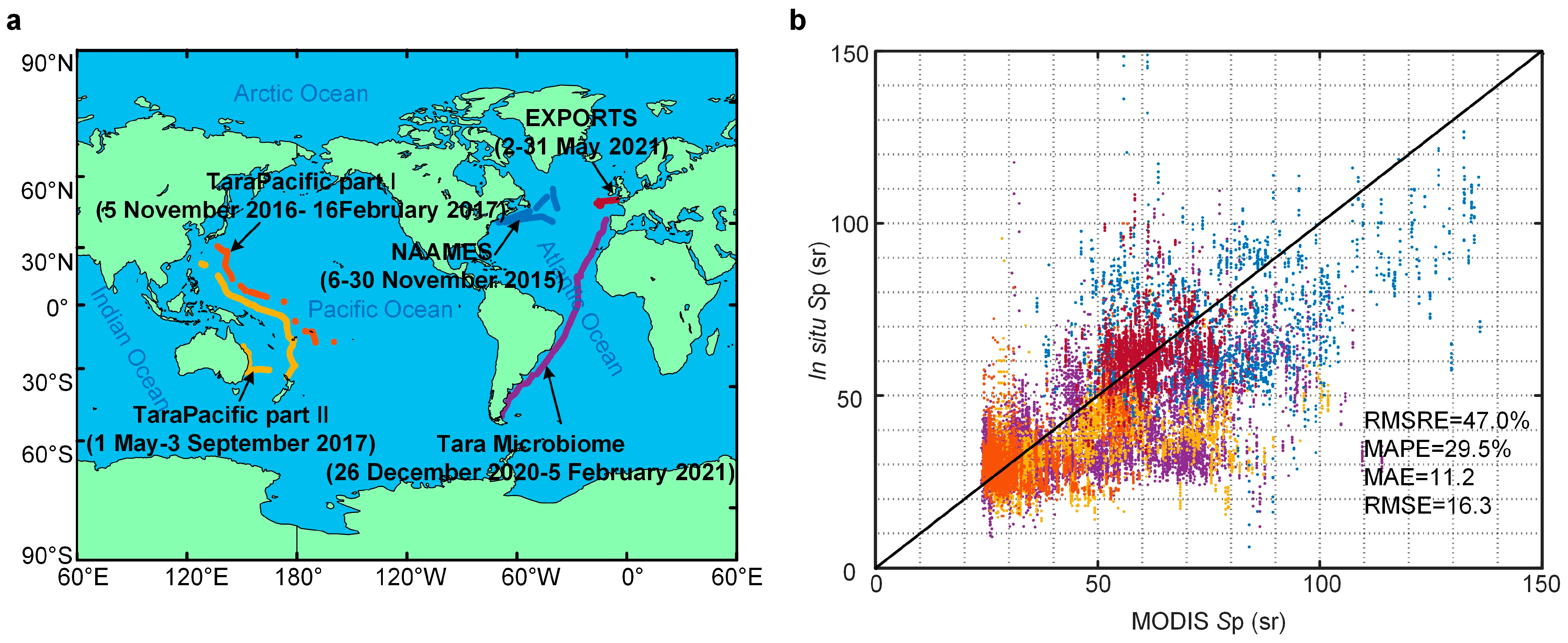

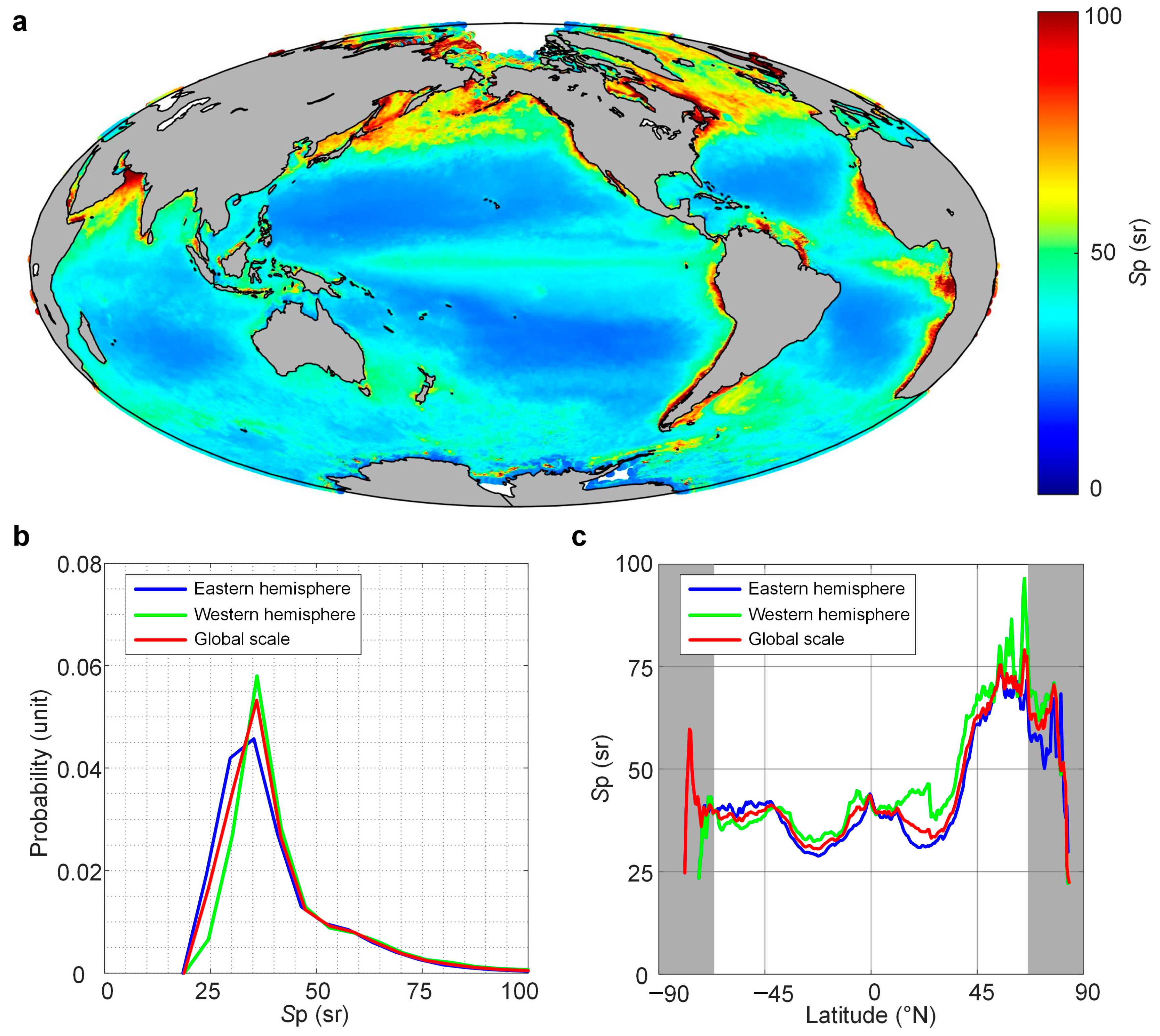
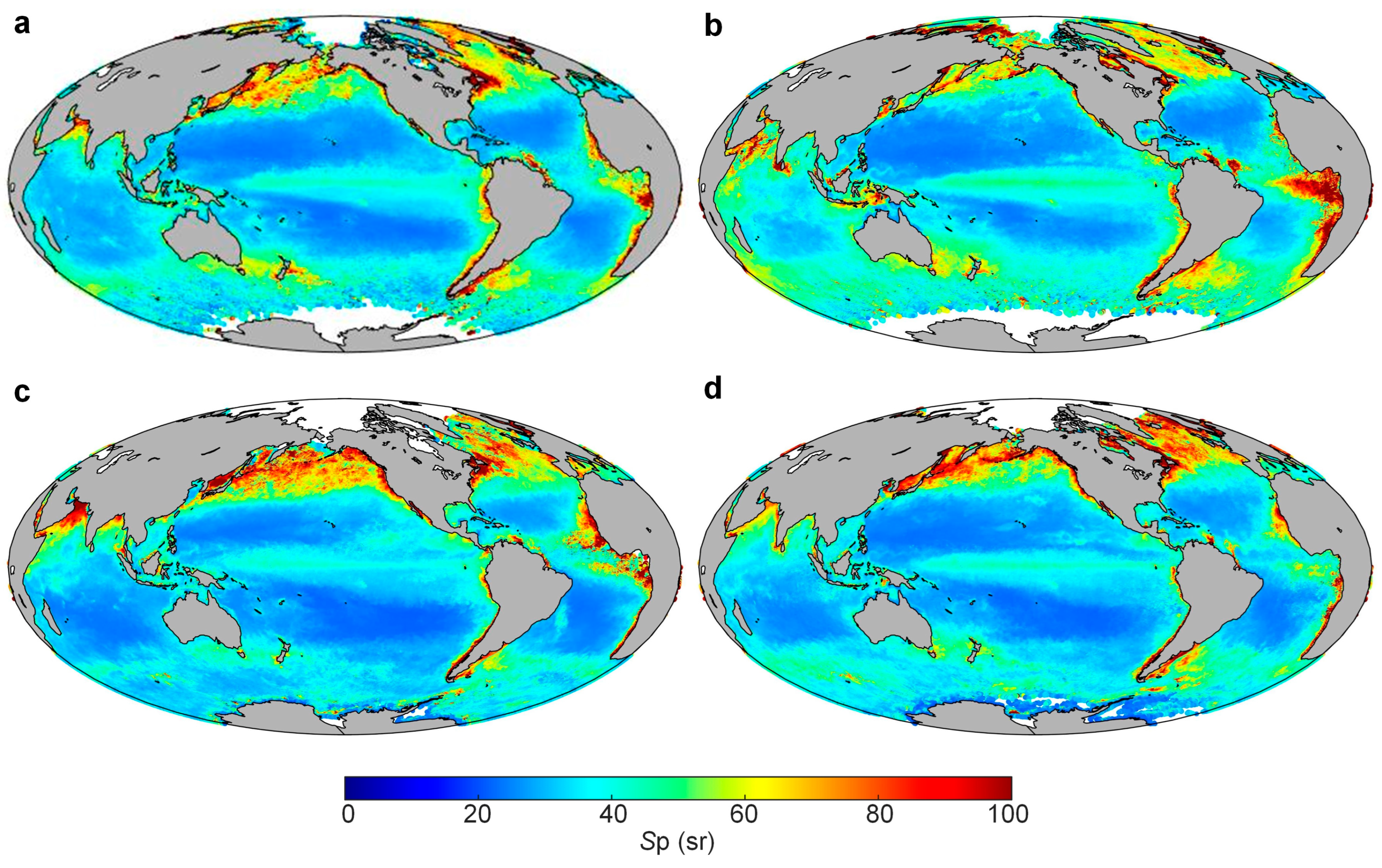
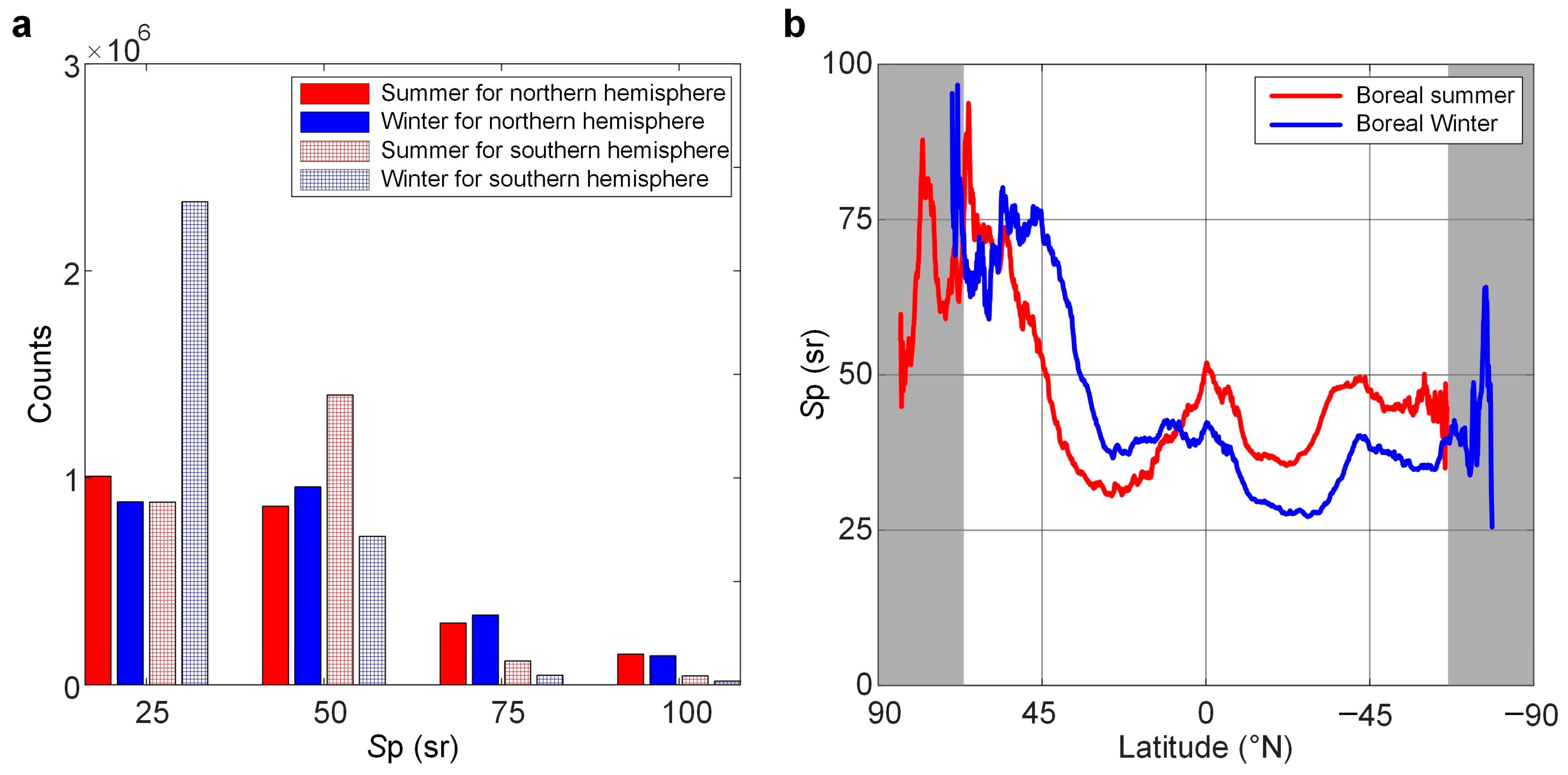
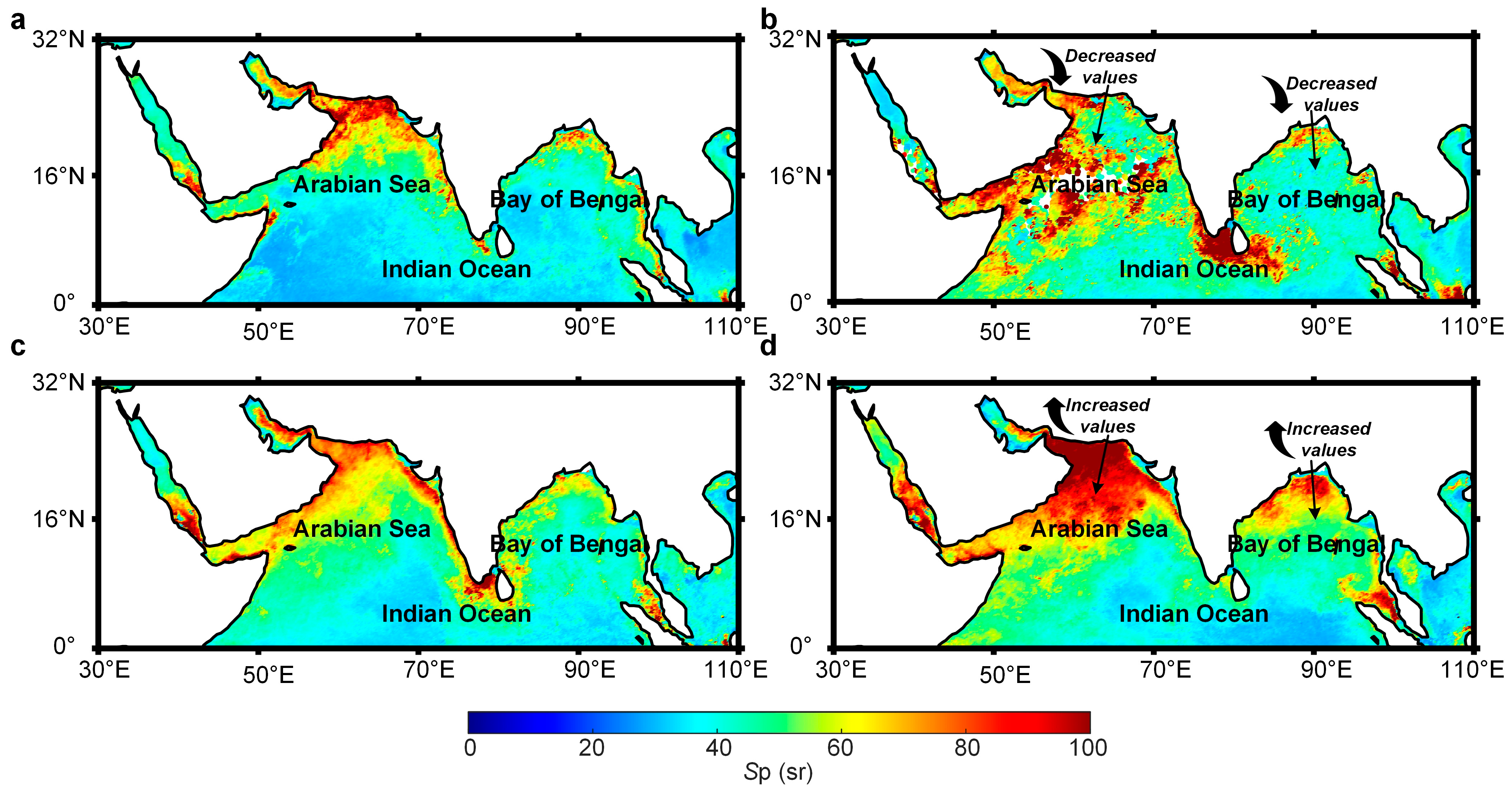
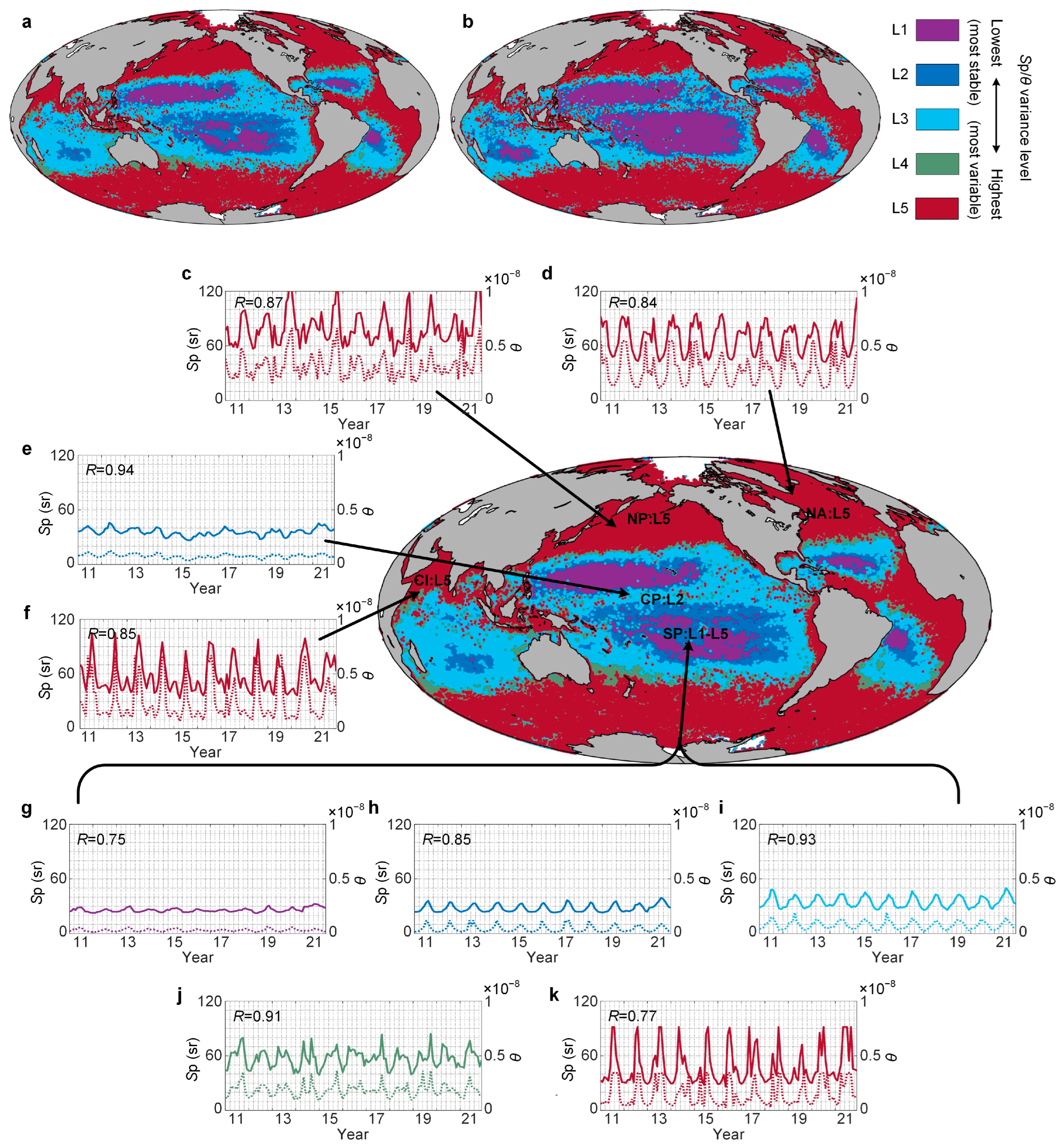
Disclaimer/Publisher’s Note: The statements, opinions and data contained in all publications are solely those of the individual author(s) and contributor(s) and not of MDPI and/or the editor(s). MDPI and/or the editor(s) disclaim responsibility for any injury to people or property resulting from any ideas, methods, instructions or products referred to in the content. |
© 2023 by the authors. Licensee MDPI, Basel, Switzerland. This article is an open access article distributed under the terms and conditions of the Creative Commons Attribution (CC BY) license (https://creativecommons.org/licenses/by/4.0/).
Share and Cite
Zhu, X.; Zhao, H.; Hu, E.; Gao, Y.; Zhou, Y.; Liu, D. Estimation of the Seawater Lidar Ratio by MODIS: Spatial–Temporal Characteristics and Ecological Significance. Remote Sens. 2023, 15, 3328. https://doi.org/10.3390/rs15133328
Zhu X, Zhao H, Hu E, Gao Y, Zhou Y, Liu D. Estimation of the Seawater Lidar Ratio by MODIS: Spatial–Temporal Characteristics and Ecological Significance. Remote Sensing. 2023; 15(13):3328. https://doi.org/10.3390/rs15133328
Chicago/Turabian StyleZhu, Xiaoan, Hongkai Zhao, Enjie Hu, Yubin Gao, Yudi Zhou, and Dong Liu. 2023. "Estimation of the Seawater Lidar Ratio by MODIS: Spatial–Temporal Characteristics and Ecological Significance" Remote Sensing 15, no. 13: 3328. https://doi.org/10.3390/rs15133328
APA StyleZhu, X., Zhao, H., Hu, E., Gao, Y., Zhou, Y., & Liu, D. (2023). Estimation of the Seawater Lidar Ratio by MODIS: Spatial–Temporal Characteristics and Ecological Significance. Remote Sensing, 15(13), 3328. https://doi.org/10.3390/rs15133328





